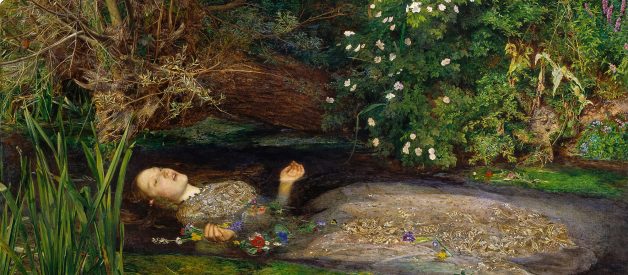An extraordinarily rich painting by a Pre-Raphaelite artist, depicting both death and life
 Ophelia (1851) by John Everett Millais. Oli on canvas. Tate, London. Image source Wikimedia Commons
Ophelia (1851) by John Everett Millais. Oli on canvas. Tate, London. Image source Wikimedia Commons
This painting, by the British artist John Everett Millais, shows a young woman lying on her back in a small river. Her name is Ophelia, a character in the play Hamlet by William Shakespeare. Ophelia is a young noblewoman who is driven to madness when her father, Polonius, is murdered by her lover, Hamlet.
 Detail of ?Ophelia? (1851) by John Everett Millais. Oli on canvas. Tate, London. Image source Wikimedia Commons
Detail of ?Ophelia? (1851) by John Everett Millais. Oli on canvas. Tate, London. Image source Wikimedia Commons
As Ophelia sinks into the river, she appears to be resigned to her fate. Her face is calm and impassive ? in fact, she appears to be singing. One can feel the steady swirl of water passing over her middle. The water is slowly overtaking her embroidered dress, seeming to keep her afloat for a moment, whilst also pulling her downwards into the brook.
The position of her hands are particularly interesting. They are raised and open, possibly in a gesture of prayer known as the orans posture.
The orans posture was a common form of prayer in early Christianity. In art, it is often seen in catacombs or on sarcophagi and is used for images of saints interceding (praying) for the dead. As an opening up of the body, the prayer gesture indicates an opening up to God?s benign will. So the position of Ophelia?s hands may represent her submission to God?s will as she approaches death.
Ophelia?s watery demise occurs in Act IV of Hamlet. The scene is not shown on stage, but is described by Queen Gertrude in poetic verse. Gertrude reports that Ophelia had climbed into a willow tree above a brook and that part of the branch broke ? Clambering to hang, an envious sliver broke ? dropping Ophelia into the water.
Here is the full description:
There is a willow grows aslant a brook,That shows his hoar leaves in the glassy stream;There with fantastic garlands did she comeOf crow-flowers, nettles, daisies, and long purplesThat liberal shepherds give a grosser name,But our cold maids do dead men?s fingers call them:There, on the pendent boughs her coronet weedsClambering to hang, an envious sliver broke;When down her weedy trophies and herselfFell in the weeping brook. Her clothes spread wide;And, mermaid-like, awhile they bore her up:Which time she chanted snatches of old tunes;As one incapable of her own distress,Or like a creature native and induedUnto that element: but long it could not beTill that her garments, heavy with their drink,Pull?d the poor wretch from her melodious layTo muddy death.
The painting shows us the very moment when Ophelia has fallen from the broken tree branch. She begins to sing ? Which time she chanted snatches of old tunes ? and without struggle, sinks into the water.
It strikes me that the first remarkable aspect of this painting is that the artist was able to give form to a piece of theatrical description. Ophelia?s death is not depicted in Hamlet, yet through this painting we are able to glimpse the event, made particular and unique by Millais? artistic choices.
Rich with detail
The second remarkable aspect is the plethora of detail that populate the painting. Take a walk in the English countryside during late spring and you will come across so many of the varieties of flora that give the painting its unusual resonance. For whilst the subject of the work is undoubtedly about death, the painting is verdant with organic life.
 Detail of ?Ophelia? (1851) by John Everett Millais. Oli on canvas. Tate, London. Image source Wikimedia Commons
Detail of ?Ophelia? (1851) by John Everett Millais. Oli on canvas. Tate, London. Image source Wikimedia Commons
Millais began working on the painting in the summer of 1851. He took great care to search for a suitable spot on the River Ewell, near to where he lived, where a broken tree branch and the grassy water plants most closely matched Shakespeare?s description.
In a letter to his friend Mrs Combe, he wrote of the heat of the summer sun as he worked: ?I sit tailor-fashion under an umbrella throwing a shadow scarcely larger than a halfpenny for eleven hours, with a child?s mug within reach to satisfy my thirst from the running stream beside me.?
The painting successfully blends a realistic depiction of the natural world with details that have symbolic pertinence. The very many varieties of flower that float alongside Ophelia?s body, for instance, may be read as portents of her melancholy fate. The prominent red poppy floating on the water near her right hand represents sleep and death. Daisies represent innocence. The weeping willow tree leaning over the river is a symbol of forsaken love.
 Detail of ?Ophelia? (1851) by John Everett Millais. Oli on canvas. Tate, London. Image source Wikimedia Commons
Detail of ?Ophelia? (1851) by John Everett Millais. Oli on canvas. Tate, London. Image source Wikimedia Commons
One detail that is easy to miss is in the top left-hand corner, where a small bird is shown perched on a branch. It is a robin, a common species in the British Isles ? and in British folklore too. Robins tend to find an elevated spot to hunt from, scouring the ground beneath them for invertebrate prey before leaping down to seize them.
The robin?s presence in the image is meaningful since robins are considered a friendly and tame garden bird, and many superstitions tell that it is unlucky to harm them. Ominous fates lie ahead for those that do; as such, the robin is also associated with imminent death.
The Pre-Raphaelite Brotherhood
The second phase of the painting was completed in Millais? London home during the following winter. The artist persuaded the 19-year-old model Elizabeth Siddal to lie fully clothed in a full bathtub to recreate the watery scene.
In an attempt to keep the bath water warm, Millais placed oil lamps beneath the tub. Their effect was negligible: Siddal caught a severe cold, which in turn prompted her father to raise a complaint against the artist with a threat of 50 damages.
Accuracy in detail was important to Millais. He was a member of the Pre-Raphaelite Brotherhood, a group of Victorian painters who were determined to make their paintings from direct encounters with nature. Artifice and hyperbole were to be avoided in favour of an honest account of the world as they found it. The idea of the Brotherhood was a poetic one: to live and paint with the same artistic integrity they saw in 15th Century Italian artists, as displayed, for instance, in the cycle of frescoes by Benozzo Gozzoli at the Camposanto at Pisa.
Such Renaissance artworks, which the Brotherhood saw through volumes of engravings, had an honesty and directness which they felt painting of their time lacked. ?The whole function of the artist in the world is to be a seeing and feeling creature,? wrote John Ruskin, the art critic and great champion of the Pre-Raphaelite movement, summing up the ambitions of the Brotherhood.
One has a sense that Millais? search for a specific place on the river and his dedicated act of painting it with such close attention to detail was an attempt to fulfill the Brotherhood?s spirit.
It is perhaps why, despite the morbid subject of the painting, this is an image that ultimately teems with life. As much as anything else, Millais? painting celebrates the abundance and variety of nature as he experienced it ? as a seeing and feeling creature with the power to record the world in paint.
 Ophelia (1851) by John Everett Millais. Oli on canvas. Tate, London. Image source Wikimedia Commons
Ophelia (1851) by John Everett Millais. Oli on canvas. Tate, London. Image source Wikimedia Commons
Would you like to get?
A free guide to the Essential Styles in Western Art History, plus updates and exclusive news about me and my writing? Download here.
Christopher P Jones is a writer and artist. He blogs about culture, art and life at his website


